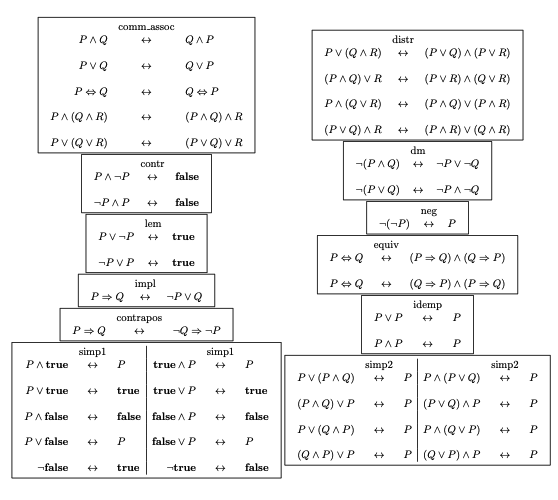- (logical implication / entailment)
- (logical equivalence)
Brackets and Precedence
- Highest
- Lowest
Binary logical connectives are right associative
Eg. means
Boolean Valuations- prime propositions are assigned truth values (T or F) and in all Boolean valuationsTautology / Valid- Propositional formula is a tautology or valid if [P] = T for all Boolean valuationsContradiction / Falsehood- Propositional formula is a contradiction or a falsehood if [A] = F for all Boolean valuationsContingent Formula- a formula that’s neither a tautology nor a contradictionConsistent- Collection of formulas are consistent if there is a Boolean valuation in which all the formulas are T
Transformational Proof

Two rules are used implicitly in transformational proofs:
Rule of substitution- Substituting an equivalent formula for a subformulaRule of transitivity- If and , then . This rule connects the steps of the proof
Rules of thumbs for transformational proofs:
- Eliminate implication and if and only if using the law of implication, the law of equivalence, and contrapositive law backwards
- Simplify as soon as you can (simp1, simp2, idemp, neg, contr, lem)
- Use the various kinds of simplification backwards to prepare for using distributivity
Conjuctive Normal Form (CNF)- Conjunction of one or more clauses, where a clause is a disjunction of literals or single literal- How to convert:
- Remove all implications and iff using laws
- If formula contains any negated compound formulas remove the neg or use DM to push the negation in
- Once a formula with no negated compound subformulas is found, use distributivity laws
- Simplify
- How to convert:
Disjunctive Normal Form (DNF)- Disjunction of one or more clauses, where a clause is a conjunction of literals or a single literal- Remove all implications and iff using laws
- If formula contains any negated compound formulas remove the neg or use DM to push the negation in
- Once formula with no negated compound subformulas is found, use distributivity laws
- Simplify
Natural Deduction
Natural deduction is a proof theory for proving the validity of an argument in propositional logic
Natural deduction is a form of forward proof
Forward Proof - Write down premises and then add formulas to the proof that we can deduce from lines already in the proof until we reach the conclusion

Subordinate Proofs - Start by choosing a formula that we can assume is true within the subproof, then we see what we can prove based on that assumption and any prev deduced formulas
3 proof rules use this approach:
- Conditional proof (imp_i)
- Proof by contradiction (raa)
- Case analysis (raa)